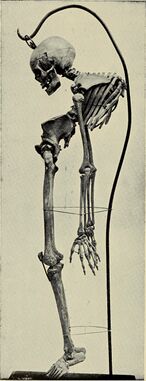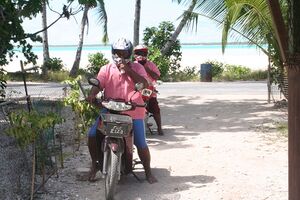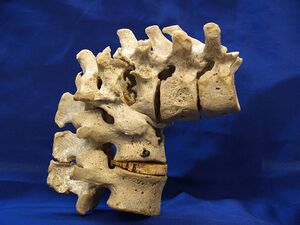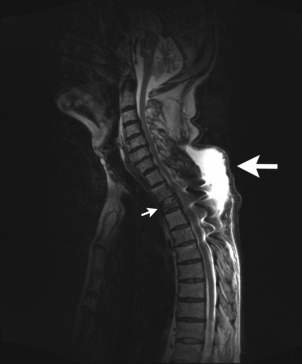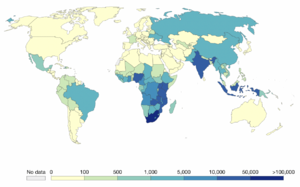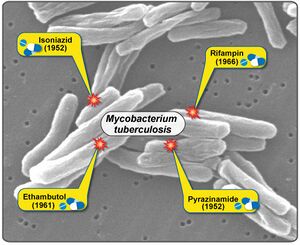Pott's Disease: Difference between revisions
No edit summary |
(reference) |
||
| (36 intermediate revisions by 12 users not shown) | |||
| Line 1: | Line 1: | ||
<div class="editorbox"> | |||
'''Original Editors '''- David Pieschel & Craig Satterley [[Pathophysiology of Complex Patient Problems|from Bellarmine University's | '''Original Editors '''- David Pieschel & Craig Satterley [[Pathophysiology of Complex Patient Problems|from Bellarmine University's Pathophysiology of Complex Patient Problems project.]] | ||
''' | '''Top Contributors''' - {{Special:Contributors/{{FULLPAGENAME}}}} | ||
</ | </div> | ||
= | == Introduction == | ||
[[File:Pott vertebra Museum (1910) (14576501749).jpeg|thumb|Vertebrae - Tuberculosis. 1910 museum.|alt=|382x382px]] | |||
Tuberculous spondylitis, also known as Pott disease, refers to vertebral body [[osteomyelitis]] and [[Spondylodiscitis|intervertebral discitis]] from [[Tuberculosis|tuberculosis (TB)]]. The [[Spinal cord anatomy|spine]] is the most frequent location of musculoskeletal tuberculosis, and commonly related symptoms are back pain, [[Kyphosis|kyphotic]] deformity of the spine, lower limb weakness, and [[paraplegia]]. <ref name=":0">Radiopedia Tuberculous spondylitis Available: https://radiopaedia.org/articles/tuberculous-spondylitis-2?lang=us<nowiki/>(accessed 14.5.2022)</ref> <ref name="Benzagmout et al.">Benzagmout M, Boujraf S, Chakour K, Chaoui M. Pott’s disease in children. Surgical Neurology International. 2011; 2(1). 1-5.</ref> | |||
Lately the disease has shown a significant increase in developed nations, particularly among the [[Immunocompromised Client|immunosuppressed population]] secondary to global migration and travel. There has been an ominous, increasing trend in the occurrence of [[Antimicrobial Resistance|multidrug-resistant bacterial strains]] of tuberculosis in the developing nations over the past decades, a tough challenge to the global community. Accordingly, the disease continues to exist as a major, global public health menace to date.<ref name=":1">Viswanathan VK, Subramanian S. Pott Disease.Available: https://www.statpearls.com/articlelibrary/viewarticle/27579/ (accessed 14.5.2022)</ref> | |||
== | == Epidemiolgy == | ||
[[File:Community health workers specialising in treating TB prepare to make their rounds on the motorbikes. Kiribati 2009. Photo- AusAID (10687431295).jpg|thumb|Community health workers treating TB ]] | |||
Tuberculous spondylitis is one of the more common infections of spine in countries where TB is prevalent. Unfortunately, the incidence of Pott Disease, as with other forms of TB, is on the rise, due to new multiple drug resistant strains<ref name=":0" />. | |||
* Discitis and/or osteomyelitis comprise approximately 50% of all musculoskeletal tuberculosis, and usually affects the lower thoracic and upper lumbar levels of the spine.<ref name=":0" /> | |||
* The World Health Organisation (WHO) reported an incidence of 10.4 million new cases of tuberculosis in 2016, among which 46.5% of cases were reported from the South East Asian Region alone. India contributed to 23% of the global TB burden<ref name=":1" />.'''<br>''' | |||
'' | == Etiology == | ||
Pott's disease can develop when air that contains the tuberculosis-causing bacteria Mycobacterium tuberculosis is inhaled into the lungs. From the lungs, an infection can spread to the spine. The spread is hematogenous ie transmitted through the blood. Bacteria reach the spine via the hematogenous route, from the lungs or lymph nodes. It spreads via the paravertebral plexus of veins i.e Batson's plexus. Someone with active TB infects the air with aerosol droplets by spitting, sneezing, coughing, speaking etc. Each sneeze can release up to 40,000 aerosol droplets, and it only takes one infected droplet to spread TB<ref>Study.com Pott Disease Available: https://study.com/learn/lesson/potts-disease-symptoms-treatments.html<nowiki/>(accessed 14.5.2022)</ref>. | |||
Some known risk factors for TB include prolonged exposure to infected patients, immunodeficiencies (HIV, alcohol, drug abuse), overcrowding, malnutrition, poverty, and lower socio-economic situation.<ref name=":1" /> | |||
== Types of Vertebral Tuberculosis == | |||
Lesions in the vertebrae may be of the following types- | |||
'''''Paradiscal:''''' | |||
* This is the commonest type. | |||
* The contiguous areas of two adjacent vertebrae along with the intervening disc are affected. | |||
'''''Central:''''' | |||
* The body of a single vertebra is affected. | |||
* This leads to early collapse of the weakened vertebra. | |||
* The nearby disc may be normal. | |||
'''''Anterior:''''' | |||
* The infection is localized to the anterior part of the vertebral body. | |||
* The infection spreads up and down under the anterior longitudinal ligament. | |||
'''''Posterior:''''' | |||
* The posterior complex of the vertebra i.e., the pedicle, lamina, spinous process and transverse process are affected <ref>Garg RK, Somvanshi DS. [https://www.ncbi.nlm.nih.gov/pmc/articles/PMC3184481/ Spinal tuberculosis: a review.] The journal of spinal cord medicine. 2011 Sep 1;34(5):440-54.</ref> | |||
== Characteristics/Clinical Presentation == | |||
[[File:Tuberculosis kyphosis.jpeg|thumb|TB, kyphosis spine]] | |||
The clinical presentation of spinal tuberculosis is variable. The manifestations depend upon the duration of illness, severity of the disease, site of the lesion, and presence of associated complications including deformity and neurological deficit. | |||
# In uncomplicated disease, the patient typically presents with back pain. Back pain in tuberculosis can be related to the active disease itself (secondary to inflammation), bone destruction and instability. Rest pain is pathognomonic, and rarely, radicular pain can be the main presenting symptom. | |||
# In complicated tubercular spine disease patient may present with deformity, instability, and neuro deficit. | |||
[[File:Pott's_Disease_Abscess.jpg|alt=|thumb|364x364px|Pott's Disease Cold Abscess]]Constitutional symptoms including weight or appetite loss, fever, and malaise/ fatigue are less commonly associated with extrapulmonary tuberculosis than pulmonary disease.<ref name=":1" /> | |||
* Cold Abscess: These abscesses typically lack all the inflammatory signs obvious in abscesses; and hence the name. | |||
* Deformity: Owing to the greater involvement of the anterior spinal column in TB, the spinal column progressively develops a kyphosis, especially in the thoracic and thoracolumbar spine. | |||
* Neurological Deficit: Can occur either at the active stage of the disease (secondary to compression from an abscess, inflammatory tissue, sequestrum or spinal instability) or during the healed stage (usually secondary to mechanical traction spinal defect. | |||
* Pediatric Spinal TB: Due to the immaturity and increased flexibility of the spine in children, they are prone to developing severe deformity progression. Such worsening of deformity in children can also occur after the disease has completely healed, and follow-up is needed until skeletal maturity<ref name=":1" />. | |||
* | |||
== Associated Co-morbidities == | == Associated Co-morbidities == | ||
[[File:Screen Shot 2022-05-14 at 2.55.25 pm.png|thumb|''Estimated TB-related deaths among people living with HIV'']] | |||
Include: Immunosuppressive Disorders; HIV/AIDS; TB; Gastrectomy; Peptic Ulcer; Drug Addiction; Alcoholism; Malnourishment; Low Socioeconomic Status | |||
== Diagnosis == | |||
For the detection of Tuberculosis, the following diagnostic tests are preferable- | |||
== | |||
* | * Chest X-ray | ||
* | * Sputum cultures (to look for the presence of bacteria) | ||
* | * Blood culture | ||
* | * Tissue biopsy (to check for the possibilities of cancer) | ||
* | * Mantoux Tuberculin skin tests ( results are positive in 84-95% of the patients having Pott’s disease) | ||
* [[CT Scans|CT]] scanning: provides much better bony detail of irregular lytic lesions, sclerosis, disk collapse, and disruption of bone circumference. Low contrast resolution provides a better assessment of soft tissue, particularly in epidural and paraspinal areas. CT scanning reveals early lesions and is more effective for defining the shape and calcification of soft tissue abscesses which is common in TB lesions.<ref name="Hidalgo and Cunha">Hidalgo JA, Cunha BA. Medscape Reference [Internet]. WebMD. Updated 2011 Dec 5. Accessed 2012 Mar 28. Available from: http://emedicine.medscape.com/article/226141-overview#a0104.</ref> | |||
* [[MRI Scans|MRI]] is the criterion gold standard for evaluating disk-space infection and osteomyelitis of the spine and is most effective for demonstrating the extension of disease into soft tissue and the spread of tuberculous debris under the anterior and posterior longitudinal ligaments.MRI is also called the most effective imaging study for demonstrating neural compression. MRI findings useful to differentiate tuberculosis spondylitis from pyogenic spondylitis include thin and smooth enhancement of the abscess wall and well-defined paraspinal abnormal signal, whereas thick and irregular enhancement of abscess wall and ill-defined paraspinal abnormal signal suggest pyogenic spondylitis. Thus, contrast-enhanced MRI appears to be important in the differentiation of these two types of spondylitis.<ref name="Hidalgo and Cunha" /> | |||
* Biopsy: Use of a percutaneous CT-guided needle biopsy of bone lesions can be used to obtain tissue samples. This is a safe procedure that also allows therapeutic drainage of large paraspinal abscesses.<ref name="Hidalgo and Cunha" /> | |||
* Polymerase Chain Reaction (PCR)''':''' PCR techniques amplify species-specific DNA sequences which is able to rapidly detect and diagnose several strains of mycobacterium without the need for prolonged culture. They have also been used to identify discrete genetic mutations in DNA sequences associated with drug resistance.<ref name="Khoo et al">Khoo LT, Mikawa K, Fessler RG. A surgical revisitation of Pott distemper of the spine. The Spine Journal. 2003; 130-145.</ref> | |||
== Medical Management == | |||
[[File:Treatment of Tuberculosis (TB) for Drug-Sensitive TB (5102889450).jpeg|thumb|TB usually be cured with a combination of first-line drugs.]] | |||
The mainstay of treatment in spinal TB is [[Chemotherapy Side Effects and Syndromes|chemotherapy]] (antitubercular treatment). Tubercle bacilli may exist as intracellular or extracellular forms or as dormant or rapidly multiplying forms. Multi-drug treatment is essential to attack the bacilli in various stages or forms and reduce the instance of drug resistance. | |||
It is essential to classify spinal TB disease into a complicated and uncomplicated disease, based on their presentation. | |||
# Uncomplicated spinal TB is essentially a medical disease. | |||
# Complicated TB spine patients need surgical intervention in addition to chemotherapy.<ref name=":1" /> | |||
#* The first line of treatment for Pott’s disease is the surgical removal of the tubercular infection. Administration of anti-tubercular medications is done before and after the surgery. This procedure is followed by the surgical reconstruction of the spine. | |||
#* The treatment protocol is formulated based on the presence or absence of neurological involvement. In case of neurological involvement usually, pharmacotherapy is preferred over surgery. The anti-tubercular medications employed in the pharmacotherapy are Isoniazid, Rifampicin, Ethambutol, and Pyrazinamide<ref>Fact Dr Potts Disease Available: https://factdr.com/health-conditions/potts-disease/<nowiki/>(accessed 14.5.2022)</ref>. | |||
#* Surgery done during the active course of the disease is much safer with a faster and better response.<ref name="Kumar et al.">Kumar R, Srivastava K, Tiwari RK. Surgical management of Pott’s disease of the spine in pediatric patients: A single surgeon’s experience of 8 years in a tertiary care center. Journal of Pediatric Neurosciences. 2011; 6: 101-108.</ref> | |||
== Education == | |||
Patient education is of extremly importance in the management of TB at the level of an individual, as well as the whole community. | |||
* The need for isolation of patients who can potentially transmit the disease is paramount. | |||
* Strict compliance to long term chemotherapy is essential for complete cure from the infection. | |||
* In pediatric disease, the chances of progression of deformity even years after healing of the infection and the need for regular follow-up until skeletal maturity need to be clearly communicated to the parents<ref name=":1" />. | |||
== Physical Therapy Management | == Physical Therapy Management == | ||
Patients with Pott's disease often undergo spinal fusion or spinal decompression | Patients with Pott's disease often undergo spinal fusion or spinal decompression surgeries to correct their structural deformity and prevent further neurological complications. There are no established guidelines which dictate treatments that will yield positive outcomes in such patients. However, treatment regimens should address each patient individually, focusing on any impairments, functional limitations and/or disabilities with which they present. | ||
PT | PT Managment Post-Spinal Decompression Surgery | ||
*Spinal Stabilization Exercises | *[[Spinal Stabilization]] Exercises | ||
*Maitland | *[[Maitland's Mobilisations|Maitland]] | ||
*Back School | *[[Back School]] | ||
*Exercise and Strengthening | *Exercise and Strengthening | ||
When compared with other physical therapy treatments and self-managment, spinal stabilization exercises were found to produce significantly more positive ratings in global outcomes. | When compared with other physical therapy treatments and self-managment, spinal stabilization exercises were found to produce significantly more positive ratings in global outcomes. Pain and disability, however, did not show significant improvement when compared to the other two treatment options.<ref name="Mannion et al.">Mannion AF, Denzler R, Dvorak J, Muntener M, Grob D. A randomised controlled trial of post-operative rehabilitation after surgical decompression of the lumbar spine. Eur Spine J (2007) 16:1101–1117.</ref> | ||
PT Managment Post-Spinal Fusion Surgery | PT Managment Post-Spinal Fusion Surgery | ||
| Line 319: | Line 112: | ||
*Overground Training (Walking Program) | *Overground Training (Walking Program) | ||
*Aerobic Exercise | *Aerobic Exercise | ||
*Trunk | *Trunk Strengthening | ||
Studies examining the use of TENS have shown higher frequencies are more effective in decreasing neuropathic pain. Aerobic exercise, PT, and trunk strengthening interventions have all attained significant decreases in pain, psychological distress and disability.<ref name="Pons and Shipton">Pons T, Shipton EA. Multilevel lumbar fusion and postoperative physiotherapy rehabilitation in a patient with persistent pain. Physiotherapy Theory and Practice. 2011; 27(3):238-245.</ref><br> | |||
== Case Reports == | |||
'''Adegboye OA.'''[http://www.ncbi.nlm.nih.gov/pmc/articles/PMC3237173/?tool=pmcentrez '''Non-Hodgkin's lymphoma “masquerading” as Pott's disease in a 13-year old boy''']'''. ''Indian Journal of Medical and Paediatric Oncology''. 2011 Apr-Jun; 32(2): 101–104.''' | |||
== Case Reports | |||
'''Adegboye OA. | |||
A 13 year old boy presenting with back inflammation, lower extremity paralysis, bowel and bladder incontinence, progressive weight loss, numbness below T10 and low grade fever. Radiographs taken indicative of Pott's disease. | A 13 year old boy presenting with back inflammation, lower extremity paralysis, bowel and bladder incontinence, progressive weight loss, numbness below T10 and low grade fever. Radiographs taken indicative of Pott's disease. | ||
'''Lotfinia I, Vahedi P.'''[http://www.ncbi.nlm.nih.gov/pmc/articles/PMC2899618/?tool=pmcentrez '''Late-onset post-diskectomy tuberculosis at the same operated lumbar level: case report and review of literature''']'''. ''European Spine Journal.'' 2010 July; 19(Suppl 2): 226–232.''' | |||
'''Lotfinia I, Vahedi P. | |||
A 43 y/o male presents with chronic low back pain for 4 months with intermittent pus drainage from his scar status post lumbar discectomy 8 years previously. Patient reported no history of TB but he had worked as a secretary at a hospital for years. | |||
== References == | == References == | ||
<references /> | |||
[[Category:Medical]] [[Category:Bellarmine_Student_Project]] | |||
[[Category: | [[Category:Communicable Diseases]] | ||
[[Category:Global Health]] | |||
[[Category:Bone - Conditions]] | |||
Latest revision as of 06:45, 27 July 2023
Original Editors - David Pieschel & Craig Satterley from Bellarmine University's Pathophysiology of Complex Patient Problems project.
Top Contributors - Craig Satterley, Lucinda hampton, Admin, Elaine Lonnemann, Joao Costa, Sai Kripa, David Pieschel, WikiSysop, Kim Jackson, Nupur Smit Shah, 127.0.0.1, Wendy Walker and Evan Thomas
Introduction[edit | edit source]
Tuberculous spondylitis, also known as Pott disease, refers to vertebral body osteomyelitis and intervertebral discitis from tuberculosis (TB). The spine is the most frequent location of musculoskeletal tuberculosis, and commonly related symptoms are back pain, kyphotic deformity of the spine, lower limb weakness, and paraplegia. [1] [2]
Lately the disease has shown a significant increase in developed nations, particularly among the immunosuppressed population secondary to global migration and travel. There has been an ominous, increasing trend in the occurrence of multidrug-resistant bacterial strains of tuberculosis in the developing nations over the past decades, a tough challenge to the global community. Accordingly, the disease continues to exist as a major, global public health menace to date.[3]
Epidemiolgy[edit | edit source]
Tuberculous spondylitis is one of the more common infections of spine in countries where TB is prevalent. Unfortunately, the incidence of Pott Disease, as with other forms of TB, is on the rise, due to new multiple drug resistant strains[1].
- Discitis and/or osteomyelitis comprise approximately 50% of all musculoskeletal tuberculosis, and usually affects the lower thoracic and upper lumbar levels of the spine.[1]
- The World Health Organisation (WHO) reported an incidence of 10.4 million new cases of tuberculosis in 2016, among which 46.5% of cases were reported from the South East Asian Region alone. India contributed to 23% of the global TB burden[3].
Etiology[edit | edit source]
Pott's disease can develop when air that contains the tuberculosis-causing bacteria Mycobacterium tuberculosis is inhaled into the lungs. From the lungs, an infection can spread to the spine. The spread is hematogenous ie transmitted through the blood. Bacteria reach the spine via the hematogenous route, from the lungs or lymph nodes. It spreads via the paravertebral plexus of veins i.e Batson's plexus. Someone with active TB infects the air with aerosol droplets by spitting, sneezing, coughing, speaking etc. Each sneeze can release up to 40,000 aerosol droplets, and it only takes one infected droplet to spread TB[4].
Some known risk factors for TB include prolonged exposure to infected patients, immunodeficiencies (HIV, alcohol, drug abuse), overcrowding, malnutrition, poverty, and lower socio-economic situation.[3]
Types of Vertebral Tuberculosis[edit | edit source]
Lesions in the vertebrae may be of the following types-
Paradiscal:
- This is the commonest type.
- The contiguous areas of two adjacent vertebrae along with the intervening disc are affected.
Central:
- The body of a single vertebra is affected.
- This leads to early collapse of the weakened vertebra.
- The nearby disc may be normal.
Anterior:
- The infection is localized to the anterior part of the vertebral body.
- The infection spreads up and down under the anterior longitudinal ligament.
Posterior:
- The posterior complex of the vertebra i.e., the pedicle, lamina, spinous process and transverse process are affected [5]
Characteristics/Clinical Presentation[edit | edit source]
The clinical presentation of spinal tuberculosis is variable. The manifestations depend upon the duration of illness, severity of the disease, site of the lesion, and presence of associated complications including deformity and neurological deficit.
- In uncomplicated disease, the patient typically presents with back pain. Back pain in tuberculosis can be related to the active disease itself (secondary to inflammation), bone destruction and instability. Rest pain is pathognomonic, and rarely, radicular pain can be the main presenting symptom.
- In complicated tubercular spine disease patient may present with deformity, instability, and neuro deficit.
Constitutional symptoms including weight or appetite loss, fever, and malaise/ fatigue are less commonly associated with extrapulmonary tuberculosis than pulmonary disease.[3]
- Cold Abscess: These abscesses typically lack all the inflammatory signs obvious in abscesses; and hence the name.
- Deformity: Owing to the greater involvement of the anterior spinal column in TB, the spinal column progressively develops a kyphosis, especially in the thoracic and thoracolumbar spine.
- Neurological Deficit: Can occur either at the active stage of the disease (secondary to compression from an abscess, inflammatory tissue, sequestrum or spinal instability) or during the healed stage (usually secondary to mechanical traction spinal defect.
- Pediatric Spinal TB: Due to the immaturity and increased flexibility of the spine in children, they are prone to developing severe deformity progression. Such worsening of deformity in children can also occur after the disease has completely healed, and follow-up is needed until skeletal maturity[3].
Associated Co-morbidities[edit | edit source]
Include: Immunosuppressive Disorders; HIV/AIDS; TB; Gastrectomy; Peptic Ulcer; Drug Addiction; Alcoholism; Malnourishment; Low Socioeconomic Status
Diagnosis[edit | edit source]
For the detection of Tuberculosis, the following diagnostic tests are preferable-
- Chest X-ray
- Sputum cultures (to look for the presence of bacteria)
- Blood culture
- Tissue biopsy (to check for the possibilities of cancer)
- Mantoux Tuberculin skin tests ( results are positive in 84-95% of the patients having Pott’s disease)
- CT scanning: provides much better bony detail of irregular lytic lesions, sclerosis, disk collapse, and disruption of bone circumference. Low contrast resolution provides a better assessment of soft tissue, particularly in epidural and paraspinal areas. CT scanning reveals early lesions and is more effective for defining the shape and calcification of soft tissue abscesses which is common in TB lesions.[6]
- MRI is the criterion gold standard for evaluating disk-space infection and osteomyelitis of the spine and is most effective for demonstrating the extension of disease into soft tissue and the spread of tuberculous debris under the anterior and posterior longitudinal ligaments.MRI is also called the most effective imaging study for demonstrating neural compression. MRI findings useful to differentiate tuberculosis spondylitis from pyogenic spondylitis include thin and smooth enhancement of the abscess wall and well-defined paraspinal abnormal signal, whereas thick and irregular enhancement of abscess wall and ill-defined paraspinal abnormal signal suggest pyogenic spondylitis. Thus, contrast-enhanced MRI appears to be important in the differentiation of these two types of spondylitis.[6]
- Biopsy: Use of a percutaneous CT-guided needle biopsy of bone lesions can be used to obtain tissue samples. This is a safe procedure that also allows therapeutic drainage of large paraspinal abscesses.[6]
- Polymerase Chain Reaction (PCR): PCR techniques amplify species-specific DNA sequences which is able to rapidly detect and diagnose several strains of mycobacterium without the need for prolonged culture. They have also been used to identify discrete genetic mutations in DNA sequences associated with drug resistance.[7]
Medical Management[edit | edit source]
The mainstay of treatment in spinal TB is chemotherapy (antitubercular treatment). Tubercle bacilli may exist as intracellular or extracellular forms or as dormant or rapidly multiplying forms. Multi-drug treatment is essential to attack the bacilli in various stages or forms and reduce the instance of drug resistance.
It is essential to classify spinal TB disease into a complicated and uncomplicated disease, based on their presentation.
- Uncomplicated spinal TB is essentially a medical disease.
- Complicated TB spine patients need surgical intervention in addition to chemotherapy.[3]
- The first line of treatment for Pott’s disease is the surgical removal of the tubercular infection. Administration of anti-tubercular medications is done before and after the surgery. This procedure is followed by the surgical reconstruction of the spine.
- The treatment protocol is formulated based on the presence or absence of neurological involvement. In case of neurological involvement usually, pharmacotherapy is preferred over surgery. The anti-tubercular medications employed in the pharmacotherapy are Isoniazid, Rifampicin, Ethambutol, and Pyrazinamide[8].
- Surgery done during the active course of the disease is much safer with a faster and better response.[9]
Education[edit | edit source]
Patient education is of extremly importance in the management of TB at the level of an individual, as well as the whole community.
- The need for isolation of patients who can potentially transmit the disease is paramount.
- Strict compliance to long term chemotherapy is essential for complete cure from the infection.
- In pediatric disease, the chances of progression of deformity even years after healing of the infection and the need for regular follow-up until skeletal maturity need to be clearly communicated to the parents[3].
Physical Therapy Management[edit | edit source]
Patients with Pott's disease often undergo spinal fusion or spinal decompression surgeries to correct their structural deformity and prevent further neurological complications. There are no established guidelines which dictate treatments that will yield positive outcomes in such patients. However, treatment regimens should address each patient individually, focusing on any impairments, functional limitations and/or disabilities with which they present.
PT Managment Post-Spinal Decompression Surgery
- Spinal Stabilization Exercises
- Maitland
- Back School
- Exercise and Strengthening
When compared with other physical therapy treatments and self-managment, spinal stabilization exercises were found to produce significantly more positive ratings in global outcomes. Pain and disability, however, did not show significant improvement when compared to the other two treatment options.[10]
PT Managment Post-Spinal Fusion Surgery
- TENS (Transcutaneous Electrical Neuromuscular Stimulation)
- Aquatic Therapy
- Overground Training (Walking Program)
- Aerobic Exercise
- Trunk Strengthening
Studies examining the use of TENS have shown higher frequencies are more effective in decreasing neuropathic pain. Aerobic exercise, PT, and trunk strengthening interventions have all attained significant decreases in pain, psychological distress and disability.[11]
Case Reports[edit | edit source]
Adegboye OA.Non-Hodgkin's lymphoma “masquerading” as Pott's disease in a 13-year old boy. Indian Journal of Medical and Paediatric Oncology. 2011 Apr-Jun; 32(2): 101–104.
A 13 year old boy presenting with back inflammation, lower extremity paralysis, bowel and bladder incontinence, progressive weight loss, numbness below T10 and low grade fever. Radiographs taken indicative of Pott's disease.
Lotfinia I, Vahedi P.Late-onset post-diskectomy tuberculosis at the same operated lumbar level: case report and review of literature. European Spine Journal. 2010 July; 19(Suppl 2): 226–232.
A 43 y/o male presents with chronic low back pain for 4 months with intermittent pus drainage from his scar status post lumbar discectomy 8 years previously. Patient reported no history of TB but he had worked as a secretary at a hospital for years.
References[edit | edit source]
- ↑ 1.0 1.1 1.2 Radiopedia Tuberculous spondylitis Available: https://radiopaedia.org/articles/tuberculous-spondylitis-2?lang=us(accessed 14.5.2022)
- ↑ Benzagmout M, Boujraf S, Chakour K, Chaoui M. Pott’s disease in children. Surgical Neurology International. 2011; 2(1). 1-5.
- ↑ 3.0 3.1 3.2 3.3 3.4 3.5 3.6 Viswanathan VK, Subramanian S. Pott Disease.Available: https://www.statpearls.com/articlelibrary/viewarticle/27579/ (accessed 14.5.2022)
- ↑ Study.com Pott Disease Available: https://study.com/learn/lesson/potts-disease-symptoms-treatments.html(accessed 14.5.2022)
- ↑ Garg RK, Somvanshi DS. Spinal tuberculosis: a review. The journal of spinal cord medicine. 2011 Sep 1;34(5):440-54.
- ↑ 6.0 6.1 6.2 Hidalgo JA, Cunha BA. Medscape Reference [Internet]. WebMD. Updated 2011 Dec 5. Accessed 2012 Mar 28. Available from: http://emedicine.medscape.com/article/226141-overview#a0104.
- ↑ Khoo LT, Mikawa K, Fessler RG. A surgical revisitation of Pott distemper of the spine. The Spine Journal. 2003; 130-145.
- ↑ Fact Dr Potts Disease Available: https://factdr.com/health-conditions/potts-disease/(accessed 14.5.2022)
- ↑ Kumar R, Srivastava K, Tiwari RK. Surgical management of Pott’s disease of the spine in pediatric patients: A single surgeon’s experience of 8 years in a tertiary care center. Journal of Pediatric Neurosciences. 2011; 6: 101-108.
- ↑ Mannion AF, Denzler R, Dvorak J, Muntener M, Grob D. A randomised controlled trial of post-operative rehabilitation after surgical decompression of the lumbar spine. Eur Spine J (2007) 16:1101–1117.
- ↑ Pons T, Shipton EA. Multilevel lumbar fusion and postoperative physiotherapy rehabilitation in a patient with persistent pain. Physiotherapy Theory and Practice. 2011; 27(3):238-245.
